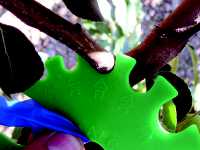Making Thinning An Exact Science

Pullquote: “We think it’s a pretty nice, simple, effective little technology to give hand thinning a scientific basis.” Jim Schupp, Penn State University
What started off as an experiment has become a valuable tool in the orchards at Penn State’s Fruit Research and Extension Center in Biglerville, PA. The Equilifruit disk was created by the National Institute for Agricultural Research (INRA) in France for use in spur pruning. While on an International Fruit Tree Association trip to Europe, the Equilifruit disk found its way into the hands of Pennsylvania grower Dan Boyer, who in turn, passed it on to Penn State researchers to see if it would be of use stateside. Jim Schupp, Associate Professor of Pomology, Fruit Research and Extension Center at Penn State University, noted that after doing some research on the original Equilifruit disk, they discovered that researchers in France had also used the original Equilifruit disk as a guide for hand thinning.
“We brought (the disk) back to the fruit center and we went to a lock of Golden Delicious that I had not adequately thinned with chemicals, and we applied a comparison. We compared hand-thinning with the Equilifruit disk to hand thinning using a rule of thumb. We did the experiments over a period of two years on Golden d=Delicious and then we also did work with it on Honeycrisp and Gala. Our results suggested that thinning using the Equilifruit F value (fruit value) resulted in more optimal crop load per tree than did the rule of thumb. And the rule of thumb, in our case, tended to consistently over-thin.”
How To Use The Disk
The Equilifruit disk is outfitted with U-shaped notches and should be placed about an inch away from the trunk, in the collar region of the limb. Once a notch is located that fits snuggly on the limb, there are two numbers underneath the notch.
“One is called the ‘F Value’ or the fruit value. That’s the number of fruit that corresponds to the size of that limb. So that’s the number of fruit you’d like left on that limb after you’ve completed hand thinning,” said Schupp. “For a mature tree, you would just find the notch that fits snuggly on a limb and read the F Value and then hand thin to that number.”
For young trees, though, “the steps are still the same, but then there’s also a triangle there with a number inside it, and we call that the delta value,” said Schupp. “On a young tree, where you want to carry a low crop load you subtract the delta value from the F value. If the F Value is 7, you’re supposed to leave 7 fruits, and the delta value is 2, then you would leave 5 fruits. That’s how you adjust for a low crop load.”
Accuracy With Use
Although it may seem like an extra hassle for growers and orchard workers to constantly refer to the Equilifruit disk, Schupp listed consistency and the ability to self-calibrate as some added bonuses for the Equilifruit disk.
“We think the Equilifruit has some real utility for providing a way of helping show your workers what you want left and being able to let them self-calibrate,” said Schupp. “Something like limb diameter, when you’re using the disk, just to find the best fit, it’s something that you do develop an eye for. And if you get it to within a fruit or two per limb, usually it ends up pretty close on a per tree basis.”
Schupp noted that “one of the challenges as this thing gets out into the real world is being patient for an hour or two, letting the workforce get used to it and once they get used to it, then I think they can go ahead and thin as fast as they ever did, but maybe to a better level of accuracy.”
Training Systems Impact Success
The success of the Equilifruit disk is dependent on the training style of the tree. Trees with renewal-style pruning are most successful, like vertical axis or spindle trees.
Schupp advises that growers that are interested in (the Equilifruit disk) should check with their local crop consultant or their ag chemical dealer.
On March 27, 2012 southern Pennsylvania had registered a daytime temperature of 27 degrees F. This was, of course, after one of the warmest March on record. The Equilifruit served another purpose in determining the severity of flower mortality.
“(March 27, 2012) was the first of a series of freezes that happened and dramatically reduced crop loads, killing blossoms in a number of regions throughout the Eastern U.S. Mercifully for us, this was our one really severe cold event, where we had mortality,” Schupp said. “We went out and collected representative limbs off of the two blocks of trees that had the worst freeze damage. One was at lower elevation and was colder, and another was Galas that for whatever reason, were out further and more susceptible. We collected representative limbs from each of those new blocks and measured the limbs’ diameter, then we would go through and cut the flowers open and investigate. In one block we had about 35% flower mortality and in another block. We had 50% (mortality). It looks really bad, until you count what’s still alive. And we had 500-700% of a crop still on the tree. In other words, we had 5, 6, or 7 times enough flowers still alive to make a crop. So we ended up having to hand thin that crop. Even though the mortality of the flowers looked horrible, we still had way more flowers than we needed to produce a full crop. In my case, that was very important to know because we had blossom thinning experiments and the question was ‘should we be even doing this?’ And the answer was, Yes. So we went ahead and did the experiments.”










